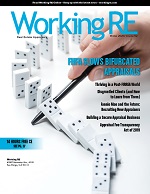 |
“One of the best courses that I have had in 17 years!” -Amy H |
>> Take OREP/Working RE’s Bifurcated Appraisal Survey
Appraiser’s (Changing) Role
Q&A with Mark Verrett, Chief Innovation Officer at Accurity Valuation
The appraisal industry is currently facing a number of challenges and growing pains as powerful stakeholders (e.g. Fannie Mae and Freddie Mac) pursue appraisal waivers, bifurcated valuations and question even the very necessity of flesh and blood appraisals. With so much uncertainty around the direction of the profession, words like “change” and “the future” are the new buzz words of the industry. Everybody is talking about what is coming next and how to prepare for it.
At the heart of the issue seems to be the increasingly central role that technology is playing in the profession. To better understand how technology is and will transform the role of the appraiser, Working RE sat down with Mark Verrett, Chief Innovation Officer at Accurity Valuation. Verrett is a second generation appraiser, focused on modernization and efficiencies in the real estate space, and is a leading voice on innovation within the appraisal industry.
WRE: What do you see as some of the biggest challenges facing appraisers today?
Verrett: While I still complete mortgage appraisals today, my perspective on challenges facing appraisers goes beyond daily practices to focus on the direction of the profession. Appraisers in the residential space will continue to have strongholds in niche markets such as consulting, green valuation, etc. for the foreseeable future, but I think the single biggest issue appraisers in the mortgage space face is relevancy. Appraisers will be hard pressed to find their place given the coming changes in the mortgage profession.
I have read articles in Bloomberg, Forbes, and USA Today predicting the industry’s move toward automation and away from the appraiser. Immediately after the sub-prime mortgage crisis, I remember first hearing the conceptual term “desktop economist” from those who were thinking about what the future of appraising might look like. The term soon became synonymous with “bifurcation,” which brings us to where we are today. I don’t think professional stakeholders have quite figured out how to optimize bifurcation and the accompanying changes that most acknowledge need to be made. Appraisers as a group rose to success because of their strong opinions and by not being easily swayed. Because of that, I think we are prone to resist change. When the stakeholders are certain that modernization is necessary but appraisers hold firm that change is bad, the question becomes: how do we stay relevant if things are going to change?
And the profession has other concerns. I have seen surveys of appraisers who no longer wish to bring their family members into the business. While anecdotal, I have seen numerous trainees go through the painstaking process of licensure only to leave the profession. The reason is that the quality of life they observed of their mentor is not for them. Another big headwind in keeping a healthy number of entrants coming into the profession is how difficult it is to incorporate a trainee into a practice profitably. It seems like today’s job seekers are searching for something different than what we all found attractive in appraising.
WRE: You mentioned optimizing bifurcation, what do you mean by that? How can appraisers benefit from appraisal bifurcation?
Verrett: FNMA and Freddie Mac are seriously exploring bifurcation and it has raised quite a bit of concern. For more than a decade, appraiser trainees on residential mortgage assignments have been disallowed from inspecting a property without a supervisor present, and from signing the left side of the report. More than 12 months ago, both GSEs openly stated that this practice was no longer disallowed. Despite appraisers now being allowed to use a trainee according to the GSEs, we found that many lenders resist enabling trainees from playing a significant role in inspecting the property and signing off a report.
(story continues)
The GSEs simultaneously have arrived at a conclusion to bifurcate the appraisal process by splitting up the inspection and the value analysis, with openness for allowing non-appraisers to perform the property inspections. As it appears now, the issue of speed is not solved in any way by this type of bifurcation, since the appraiser won’t even know they have an assignment until well after the inspection is complete. Unintentionally, over the last decade, the regulatory environment has taken away the residential appraiser’s ability to pioneer their own bifurcated process by not allowing trainees working under their direct supervision to inspect and sign reports as a contributor. I believe strongly that the profession needs to encourage the appraisal firm concept to implement the bifurcated process to meet the profession’s growing need of speed and flexibility. Accurity has spent years pioneering this process and is rolling that process out nationally where it is permitted. I am excited to see positive momentum in this direction on many fronts.
WRE: How can appraisers adapt to meet the profession demands?
Verrett: I think there are several ways to adapt to these challenges. The first is to work toward diversifying your practice away from 100 percent mortgage business niches. Our firm is a leader in green valuation, rural valuation, valuation consulting and litigation support and we help our offices diversify into those spaces. However, this solution isn’t for everyone.
To directly take on the challenges facing appraiser relevancy in the mortgage space, significant change is required. Appraisers need to unite to create a like-minded national voice that is not rejecting proposed changes for the profession, but rather working with stakeholders (regulators, lenders, clients, etc.) in conceptualizing, testing, tweaking, and ultimately modernizing the appraisal process on the mortgage side. The appraisal community has a tough assignment in their role in this modernization. To be useful in the discussion, we need to challenge ourselves to be creative and open-minded, yet diligent in maintaining or, even better, improving the quality of the valuation being produced. I think it is extremely important for appraisers to listen and understand the needs of their clients and to creatively develop solutions that meet those needs.
It is notable that to date many innovators proposing concepts to modernize the space are technology companies with new software or apps. Presently, I don’t think appraisers are considered to be good candidates to participate in developing new and innovative ways forward. Appraisers need to join that innovation space as the future users/ implementers of the technology, as well as to provide critical input and buy into the solutions proposed.
(story continues below)
(story continues)
As I listen to stakeholders and observe other industries that have experienced extreme modernization or disruption, I see a demand for speed. If we listen and observe closely we can see that all alternatives that are proposed or in use, that call into question the relevance of the appraiser’s role, relate to speed. Other countries have arrived at an appraisal process that results in much faster valuations than we see here in the USA. It is critical for the appraiser to adapt because it’s what the public demands.
WRE: As Accurity’s Chief Innovation Officer, what role do you think innovation plays in the appraisal profession?
Verrett: Chief Innovation Officer is likely an uncommon title in any appraisal organization, yet both Fannie Mae and Freddie Mac for years have had “innovations teams” that consist of industry stakeholders, conceptualizing the modernization of our profession. Traditionally, I have not seen appraisers having a seat at that table and we believe strongly that this is to our detriment. Like all industries over the last 20 years, the real estate and appraisal industries have changed. For appraisers to stay relevant, it is critical that we stay involved in that modernization conversation with a cohesive voice and open mind.
I think the appraiser’s role in this modernization movement is to do what we do best, preserve the public trust. We must be leaders in finding ways to meet the foremost need of the profession, which is speed, while ensuring that our valuation product stays reliable. I think with the availability of data and new technology, it is well within our grasp to do what was unthinkable even a decade ago. Appraisers need to find innovative ways to deliver our irreplaceable analysis and opinions with improved support and at lightning speeds. I hope that it goes without saying that this concept is only applicable to most properties that exist in the country.
If appraisers can solve the profession’s primary need of speed, I think opportunities abound for us. Leading the way and being part of the disruption of our profession is extremely exciting and on its own solves the relevancy issue for new job seekers.
WRE: How can appraisers use technology to their advantage?
Verrett: It is easy for an experienced appraiser to automatically equate quickness with lower quality. I think the appraiser’s challenge today is to prove that this isn’t true. With available technology we are proving that it’s possible. Being completely mobile is critical. Making full use of available tools to process data quickly and thoroughly is also a must. At this point, I believe that mobility and the use of data tools is a requirement in each appraiser’s practice. The challenge ahead is to maximize the use of those tools to increase efficiencies, improve the quality of analysis and deliver those results in hyper-quick speeds. Beyond data tools and mobility, I see technology as being able to be leveraged to assist and support the appraiser along their value analysis process. A team appraisal approach is a term coined to describe this process. The team approach can be difficult to develop and implement in a typically sized residential appraisal firm (1.5 people is that last number I saw estimated), not to mention that it runs contrary to how most appraisers work, with complete control end to end. It is critical that we partner together to explore and implement these efficiencies that can be employed not just in one market, but across the country. That coming together is largely our firm’s mission.
About the Author: Mark Verrett is a second generation practicing appraiser, focused on modernization and efficiencies in the real estate space. Mark was recently named the Chief Innovation Officer for Accurity Valuation, one of the nation’s largest appraisal firms. Mark was selected to serve the Appraisal Institute nationally as 3rd Director of Region VIII and is a leading voice in innovation within the appraisal industry.
>> Take OREP/Working RE’s Bifurcated Appraisal Survey
The completion rate of the survey is 100%, meaning everyone answered every question. The average time to complete the survey is three minutes. You can add your voice and comments by taking the Survey here.
CE Online – 7 Hours (AQB Approved)
Identifying and Correcting Persistent Appraisal Failures
Richard Hagar, SRA, is an educator, author and owner of a busy appraisal office in the state of Washington. Hagar now offers his legendary adjustments course for CE credit in over 40 states through OREPEducation.org. The new 7-hour online CE course Identifying and Correcting Persistent Appraisal Failures shows appraisers how to avoid CU’s red flags, minimize callbacks, save time, and earn more! Learn how to improve the quality of your reports and build defensible reports! OREP insureds save on this approved coursework. Sign up today at www.OREPEducation.org.
Sign Up Now! $119 (7 Hrs)
OREP Insured’s Price: $99
>Opt-In to Working RE Newsletters
>Shop Appraiser Insurance
>Shop Real Estate Agent
Insurance
Send your story submission/idea to the Editor:
isaac@orep.org





by Kennneth Smith
He also forgot to mention that the lenders and AMC want it fast and cheap. Cheap is what they really want
-by Steven R. Smith, MSREA, MAI, SRA
Appraisal is called a profession by many, and yet in the world of loan appraisers, it is approached as a Vocation.
The educational requirements are less than those of true professions, most of which require post graduate degrees or credentials.
Professional appraisers are not controlled by demands of speed and cheap fees {all at the same time}.
Professional appraisers charge for billable hours, usually working off of an advance fee retainer.
Professional appraisers tell the client what their work queue is, when they could start the assignment, and how long it would take to complete.
-by Shad Russo
I find it interesting that the author states the industry is being reduced to non-lender assignment, thus reducing the entire availability of assignment . The author then blames appraisers for not wanting to bring in the next generation to a collapsing industry. It is hard to scare appraisers and promote growth at the same time. What is clear in the article, is appraisers are being blamed once again. How do listing/selling agents escape this blame? Bifurcated appraisals will reduce the appraiser population due to change. The only way is to keep profitable would be to revise and scale up the amount of bifurcated assignments completed in a week. This causes errors and and a larger volume potential orders going to select appraisers. Other appraisers who rely on attorneys, etc. will have less work and lose incentive. This magazine, and its negative articles is responsible for two appraisers I know, leaving the industry.
-by Candy
If technology is so great, how comes county’s who solely rely on it for re-assessments
-have a 50% failure rate ???
by Brad Bassi
Thank you Mark. You know me so being direct will come as no surprise. Who decided that speed is all important? if speed is so important why is that we have speed limits on the freeways? Why is it that we want to rush an individual who is buying quite frankly there single largest investment in their life? I don’t see how speed makes anything better. And on speed does that mean they want an analysis of a market and subject property in one hour or one day and if so then how are we heading toward aiding the public trust. Let me give you an example “quickly”. How do you think a lender / GSE / OTC/ FHFA would like to receive a loan package with utility easement that runs through a building pad site. The title company didn’t see it (they were too busy with speed). The loan rep didn’t see it, she/he was to busy hurrying to their next loan app that they were taking on their laptop and qualifying the borrower in less than 5 minutes so that they could quickly load that file up, cross one of their forecast sales report and move on to the next borrower. You get my drift. This particular site was a 5 acre parcel with an embedded small separate area (legal lot about 1,700 sf you can do the math on site size as it was rectangular) with its own separate Assessor Parcel Number. The previous sale missed it, the previous Title company missed it, the previous underwriter missed it and dare I say the previous appraiser missed it. Why because they were all in the game of speed. This little issue had three easements on the site, which made the main building pad, unbuildable and the lower pad also unbuildable, with the easements on site. Now these were older easements and could they be extinguished, probably yes. Would take time (oh wait a minute we need this done quickly I forgot). This little mess ended up costing all parties a small fee of about $1,250,000 as the home was built and nobody caught it because we are all in a hurry. How do you think the homeowner feels about public trust. and oh by the way the title companies tried to get out of it through their long list of exclusions. I am seeing more and more of this all the time in my business. There are no easy simple cookie cutters anymore, even tract homes now have hair growing off them. Just wish I could get some hair on the top of my head to grow. Mark I respect you and understand where you are coming from, but if we substitute speed on everything, seatbelts won’t save us in a high speed crash. I think technology is great and we should take it on as part of our everyday appraisal lives. Heck I am on the backside of 65 and I am trying. But this insanity of the wolf with the key to the chicken coop clucking like a chicken and telling them everything will be okay, just ain’t going to end well. Mark you have my number so you can call and yell at me, but for heaven sake please be speedy about it, it won’t hurt me as long. Thanks and great article I just think the word speed is a bad word for this business and not in the same vain as others are portraying it. keep up the good work.
-